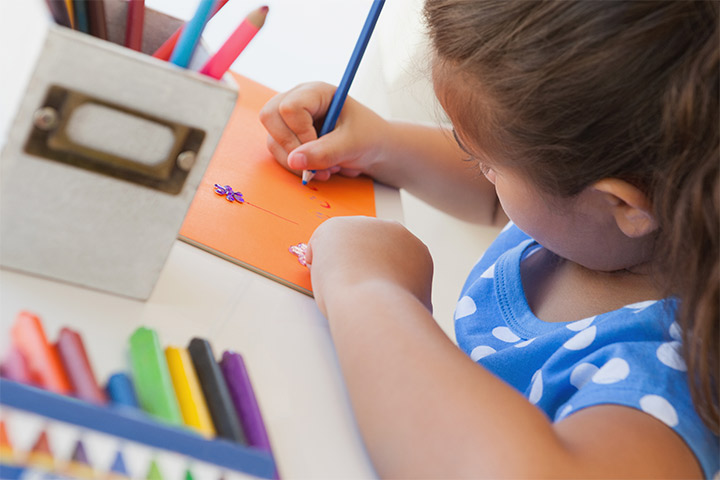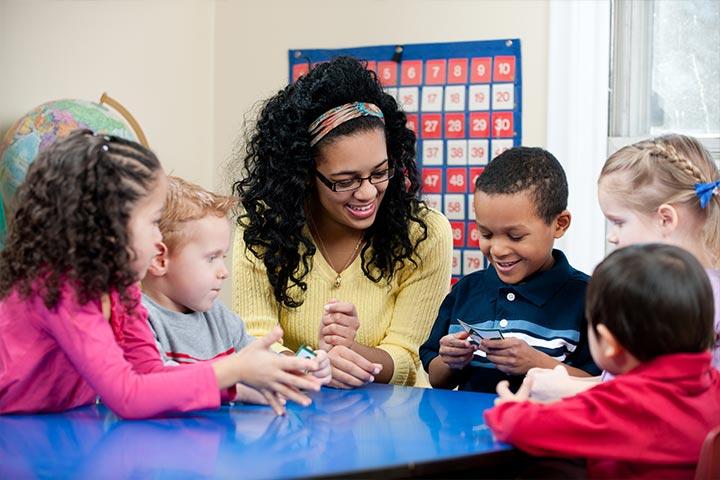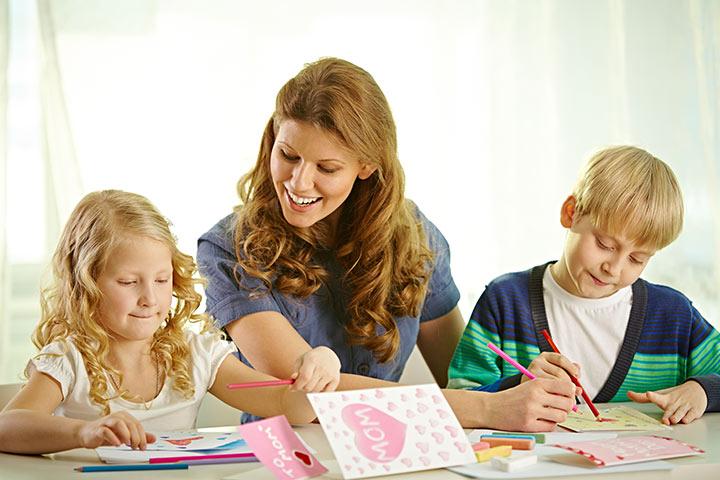Image: iStock
“I can’t be a football player. I’m not strong”. “I can’t even get good grades. I feel pathetic”.
If these statements sound familiar and your child often thinks and speaks in a manner that depicts poor self-worth, then you are not alone. Parents everywhere have to deal with their child’s self-esteem issues one time or another in their lives.
Here, MomJunction tells you what self-esteem is and how to build a child’s self-worth with self-esteem activities for kids.
What Is Self-Esteem?
In psychology, self-esteem is defined as an individual’s subjective evaluation of self. In simple terms, self-esteem is what we think of ourselves. So how does it matter what your children think of themselves? They are just children after all!A child’s degree of self-esteem can be high or low. Children with a healthy self-esteem have a positive sense of self and are more confident unlike children with a poor self-esteem, which can have a negative effect on their life choices.
While the degree of self-esteem may or not determine the child’s chances of success in academics, it can have an impact on their overall happiness (1).
Building Self-Esteem In Children
Self-esteem in children begins to develop very early, and the parent plays a critical role in building it (2). As parents are the most influential people in a child’s life, what they say or do and how they make the child feel impacts the child’s thinking process. Here are a few ways in which you can help your child develop healthy self-esteem.- Children who feel loved and accepted, love themselves and are comfortable in their skin. When you speak kind words, hug or kiss them, your children will feel loved and good about themselves. Sometimes, a simple smile can be enough to let the child know you love her.
- Focus on the child’s strengths and not on their flaws. Encourage them to use their talents without feeling embarrassed. At the same time, help them identify their weaknesses and find ways to work on them.
- Encouraging kids to succeed is good. But then, we are not always successful. Let your child understand that it is okay not to win sometimes. Teach the kid to embrace failure and let them know that success is not a measure of value.
- Learning new skills can be empowering. Teaching the child new skills, even minor ones such as gardening, doing the dishes, creating a presentation, or changing a tire, can boost their sense of self-esteem to a certain extent.
- Having the power to choose is a good feeling. Give that to your children, let them choose once in a while. It not only makes them good but also teaches them about the responsibility and the risks that come with it. But start small, with simple choices for apparel, foods, toys, etc., before giving them responsibility for major life choices.
- When you solve a problem, big or small, you experience a feeling of accomplishment. So the next time your child has a problem, don’t solve it for them. Teach them to solve it themselves. Doing so will boost their confidence and self-esteem.
- Teach the kids to care for themselves and others. Talk to them about the importance of a healthy lifestyle and taking care of themselves. You can also teach your child about personal hygiene and the art of dressing well, both of which have a positive impact on an individual’s self-confidence.
- Kids are inquisitive and want to try new things. If your children show an interest in an activity, sport, or learning a new skill, don’t discourage them. Encourage them to try and experience it, while educating them about the possible risks or outcomes.
- For instance, if the child wants to learn martial arts, encourage her. But tell her that it needs practice and discipline, which means waking up early, strength training, and long hours of practice.
Self-esteem Games And Activities For Kids
Praise may not do much good to your child’s intrinsic motivation, but mix it with activities and games that boost their confidence, and the magic works. Here are a few self-esteem games and activities that can build up a child’s self-confidence.1. ‘I am’ activity
Does your kid like herself? Is she proud of her achievements or does she feel embarrassed because of her shortfalls, if any?You’ll know the answers to that with this activity.
You will need:
Chart or drawing paper, cutouts of adjectives from magazines, glue, color pen or sketch pen
How to:
- Ask the kid to list down words that describe her on a piece of paper. It can be negative or positive.
- Then ask her to focus only on the good things that people have said about her and make a list of that.
- Paste the photo of the child in the center of the drawing or chart paper.
- Ask the child to fill the area around the picture with positive words, adjectives that she can relate to.
- Put the drawing sheet or paper in her room, for reinforcing positive beliefs about the self.
2. List your wins in life
An effective way to boost the child’s self-esteem is to remind her of her successes.You will need:
A sheet of paper, pen
How to:
- Give the child a pen and paper or notebook.
- Start by writing down the list of wins in life on the front page, leaving space at the bottom to add more later.
- To remind the child of her potential, you can also ask her to list down her wins every day, before she goes to bed.
3. Positive experiences
This can be a group activity that can be played with friends or family.You will need:
A bowl or box, index cards, space to play
How to:
- Get the kids to sit in a circle and give them one index card each.
- Ask the kids to write their names on top of the index card and put it in the bowl. Shake the bowl to mix the cards.
- Pass the bowl around and let the kids pick one index card. Ask them to write one positive thing about that person. They pass the card to the next person and the next until everyone has written at least one positive thing about that person.
- Collect all the cards and put them back in the bowl.
- Give the cards with their names back to the kids and let them read the positive things people have to say about them.
4. I am afraid but…
Fear is powerful and can prevent you from doing anything you like. This activity helps your child face her fears.You will need:
Paper and pen
How to:
- Ask the child to list out the things she is afraid to do. For instance, she could be afraid to go to swimming classes because of weight. Or she is scared of doing a class presentation or asking someone out on a date.
I am afraid to enroll in the swim team because …
I am afraid to talk to so and so because…
- The second step is to imagine doing the thing they fear. Imagine registering for that swim team or talking to that person you like.
- Develop a ‘so what’ mentality. Every time the child writes down what she is afraid of, make her write what the possible outcomes would be if she tried it. And next to the negative outcome, get them to write something like “even if I don’t make it to the team, so what?” or “even if that so and so rejects me, so what?”
5. Mother-daughter self-esteem activity
A mother is the first and the most powerful female role-model in a little girl’s life. This activity taps into the mother-daughter bond to work on the girl’s self-esteem.You will need:
Poster or chart papers, sketch pens or color pens
How to:
- Make two posters with the word ‘ME’ stenciled on them, so that you can fill the letters with text.
- Create another poster with the words “MY MOM” and another with “MY GIRL” stenciled on them.
- Give the child one “ME” poster and the “MY MOM” poster and ask her to fill it with positive things about herself and her mother. Let the mom work on the remaining two.
- Let them exchange the posters or read out the compliments they have for each other.
6. Chore with a purpose
A child’s self-esteem can get a quick boost when they know someone trusts them. What better way to show your child that you trust her than by giving her a chore that bears great responsibility.How to:
- Make a list of things that your child can do to care for the environment and animals around her. For example, walking the dog, watering the plants, or mopping the floor.
- Every time the child completes the task successfully, compliment her but do not overdo it.
7. Visualization
Our negative thoughts can be so overpowering sometimes that we cannot imagine something nice. If your child is going through such a phase, this activity can help.A calm or quiet place to relax.
How to:
- Find out why your child thinks she is not good or what she is afraid of doing.
- For example, if she is worried about school or her performance in a sport, focus on that.
- Ask her to imagine and write down what the ideal scenario, in either case, would be.
- Then, ask the child to close her eyes and imagine the ideal scenario, and how she would feel if it were real.
- Ask her to write down how she felt when she visualized the ideal situation and what she thought about herself.
8. Changing self-talk
Negative self-talk is perhaps the worst thing that can affect your child’s self-confidence. Regardless of what the others say, what you tell yourself is what you really believe. This activity helps change the negative conversations with the self into positive ones.You will need:
Pen and paper
How to:
- Make two columns on a sheet of paper. On one side, write “Bad or Negative self-talk” and on the other, write “Good or Positive self-talk.”
- Ask the child to list down all negative statements that he or she makes about herself under the Bad self-talk column.
- Next, ask the child to turn the negative statements into positive ones. The statements should be clear and specific to the talents or abilities of the kid.
Telling the child to think positive may not always work. Children feel more than they think. Engaging them in activities that remind them of their abilities and their self-worth is more effective than getting them to read a book or attend a lecture on positive self-worth. Remember that as the parent, you have a greater influence on your children. Use that influence to make them feel good about themselves. But, do not overdo it.





Comments
Post a Comment